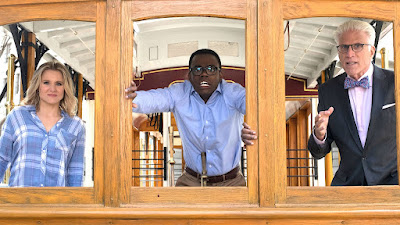Day Six: Baudrillard and The Good Place
by Isa Pedersen
Today we focused primarily on Baudrillard's theory about the simulacra and reality, and the four stages of reality and
simulation. Before we started with Baudrillard, we showed each other the Minecraft skins we had created yesterday,
and how our designs tied into the philosophical ideas we had previously discussed (Plato, Harway, and Lacan). Many
chose to focus on Haraway's cyborg theory for their skins for various reasons.
After addressing our Minecraft skins, we read the short story by Borges called “On Exactitude in Science.” This
story talks about a cartographer who made this amazing map that was so precise that it covered all of his territory,
and eventually the empire grew from the map. This short story leads directly into Baudrillard’s readings. He goes
through the four stages of simulation in regards to this map. The first stage is the reflection of basic reality, then
masks and perverts a basic reality, it makes the absence of a basic reality, and finally, it is a simulacrum, it bears
no relation to reality.
In the afternoon we watched four episodes of “The Good Place.” “The Good Place” is a TV show about the
philosophical and ethical implcations of the afterlife. Some of the episodes focus on the conflict of whether or not
the four main characters are in the “good place” or the “bad place” as the try to live in a simulation that tortures
them. During the second season, the shows looks at ethics through the experiment of the trolley scenario.
The experiment places you in a trolley and on one track there are five people, and on the other track, there's
only one. You have the option to turn the trolley to only kill one person or to stay on the same track and kill
five peoplpe. Most people would choose to only kill the one person rather than the five, but then you are asked
what you would do if you knew the one person, and more situations like that. Another closely connected example
the episode shows shifts to a medical situation--you are a doctor and you have to choose to save five people who
need a transplant by killing one healthy person to use their organs. Would you harvest the organs from the healthy
person to save five people? We only had a short conversation about this show considering it was at the very end
of the day, but we had a very fruitful discussion about the morals of the trolley and how emotions would affect this
experiment.



Comments
Post a Comment